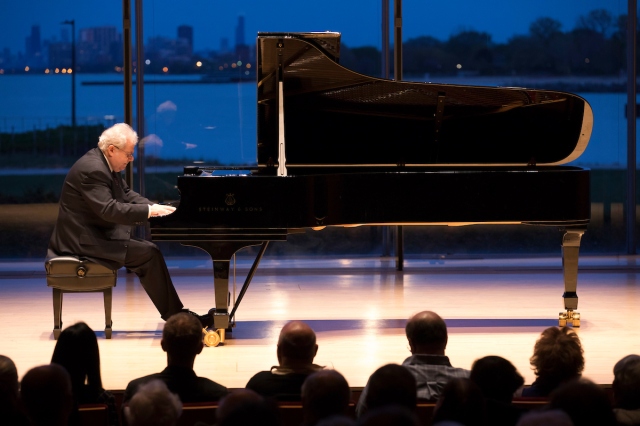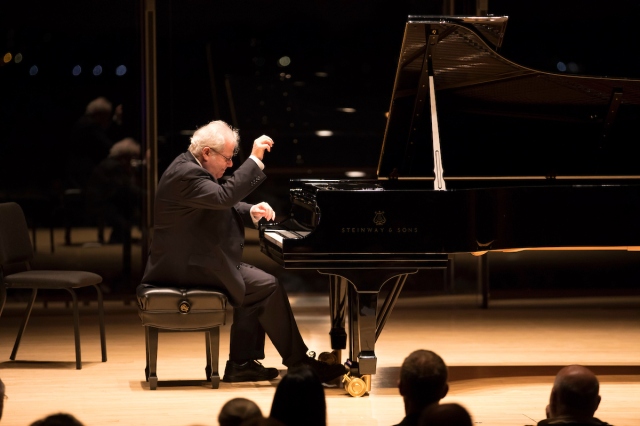Emanuel Ax, piano
Mary B. Galvin Recital Hall
Evanston, IL
May 3, 2017
Schubert: Four Impromptus, D935
Chopin: Impromptu in A-flat major, Op. 29
Chopin: Impromptu in F-sharp major, Op. 36
Chopin: Impromptu in G-flat major, Op. 51
Chopin: Fantaisie-Impromptu in C-sharp minor, Op. 66
Samuel Adams: Impromptu No. 2, “After Schubert”
Chopin: Piano Sonata No. 3 in B Minor, Op. 58
Encores:
Chopin: Nocturne in F-sharp major, Op. 15 No. 2
Chopin: Waltz in A-flat major, Op. 34 No. 1
Awarded biennially since 2006, Northwestern’s Jean Gimbel Lane Prize in Piano Performance now claims a veritable who’s who of the piano amongst its laureates. Each recipient spends time in residency on campus, working with music students and presenting a public recital, and 2016 winner Emanuel Ax closed this season’s Skyline Piano Artist Series Wednesday evening. Ax presented one of his characteristically thoughtful programs, exploring the impromptu in sterling examples by Schubert and Chopin along with a new addition to the genre by Samuel Adams, rounded off by Chopin’s incomparable B minor piano sonata.

Robert Schumann famously described Schubert’s D935 impromptus as a coherent if veiled sonata; Chopin’s four examples of the genre, however, are quite independent of one another, bearing little more in common than the rather vague title. Nonetheless, Ax presented them as a suite, an interesting approach insofar as it juxtaposed works from various points in the composer’s life. The Impromptu No. 1 in A flat major was highlighted by its songful middle section, and under Ax’s guidance the circuitous, labyrinthine coda felt entirely purposeful. In the following work, the deeply felt music yearned and grew to great passions. While it may be the least played of the Chopin impromptus, Ax made a strong case for the Impromptu No. 3 in G flat major in its arching, appealing melody. Despite its late opus number owing to posthumous publication, the familiar Fantaisie-Impromptu is the earliest of the four, and Ax gave it an energetic workout with impressive prestidigitation.
The second half opened with a 2016 work of Samuel Adams which Ax himself commissioned, and the attention to Adams’ work is certainly topical as he currently serves as one of the two Mead Composers in Residence at the Chicago Symphony. In concert with the theme of the first half, the work in question was the second of a set of three impromptus, this selection subtitled “After Schubert”. As a whole the three are intended to be inserted between each of the D935 impromptus, drawing comparison to Brett Dean’s Hommage á Brahms, which Ax presented in a 2014 recital at Symphony Center, superimposed within Brahms’ Op. 119. While it certainly would be interesting to hear the Adams in that fashion, No. 2 – a substantial piece, surpassing the 10 minute mark – functioned well independently (although I thought it would have been more logical to program it in between the Schubert and Chopin, and that way it would literally have been “after Schubert”).
Opening with quasi-Schubertian melodic fragments over a rippling accompaniment, it was as if one was experiencing distant, refracted memories of the Schubert impromptus, along with a perhaps more obvious invocation of the elder composer’s final B flat major piano sonata. Cast in Schubert’s preferred ternary form, the middle section fared somewhat repetitive, but the brief return of the A section rounded off what was generally a very attractive piece.
Departing impromptu territory, Ax concluded the program with Chopin’s Piano Sonata No. 3 in B minor, and it was here he was at his finest. The first movement was grand yet tautly structured, while the fleeting, quicksilver scherzo put the pianist’s dexterous fingers on full display. The heart of the work is in the slow movement; its declamatory opening soon melted away into a divinely gorgeous nocturne. Though filled with bravura runs and effects, the melody was never lost in the busyness of the finale which closed the work with enormous passion and drama.
The warm, enthusiastic reception brought Ax back to the keyboard for two encores, both by Chopin: an elegant account of the Nocturne in F sharp major, along with the Waltz in A flat major, stylish and buoyant.

